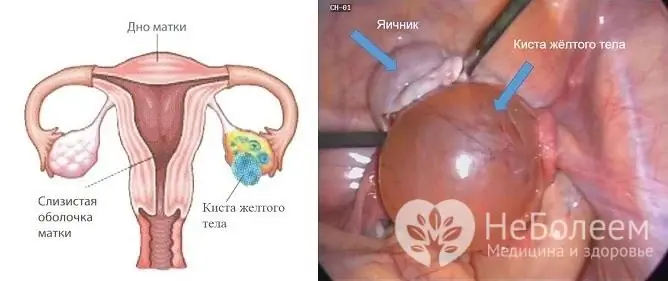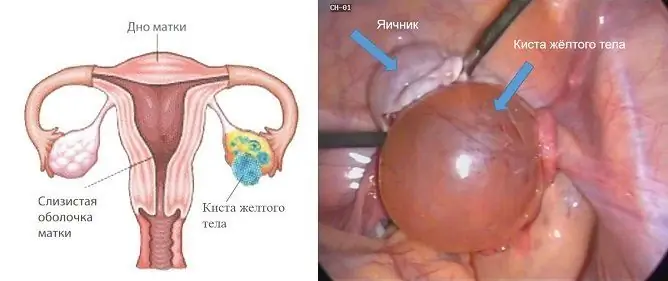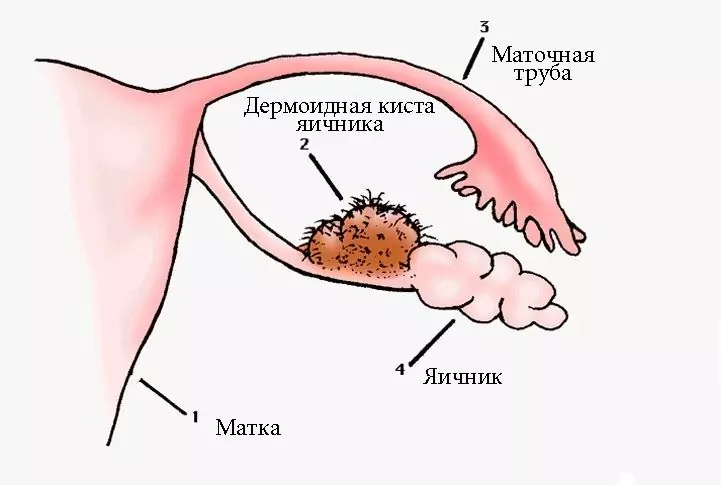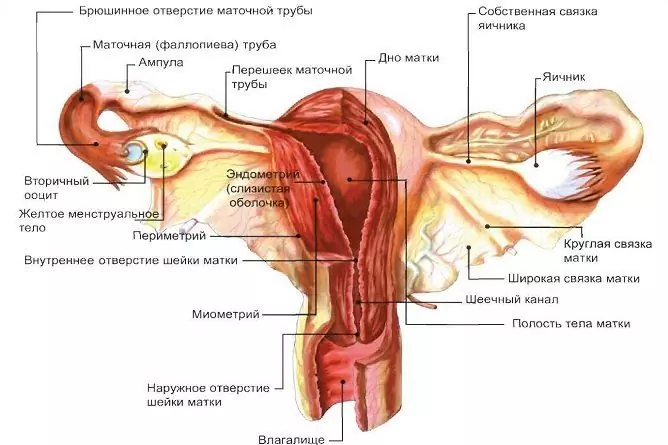- Author Rachel Wainwright [email protected].
- Public 2023-12-15 07:39.
- Last modified 2025-11-02 20:14.
Luteal ovarian cyst
The content of the article:
- Luteal ovarian cyst - what is it?
- Symptoms
- Possible complications
- The reasons
- Diagnostics
-
Treatment Approach
- Wait-and-see tactics
- Drug treatment
- Surgical removal
- General recommendations
- Diet therapy
- Video
A luteal cyst is a type of benign neoplasm that forms from the corpus luteum after ovulation under the action of pituitary luteinizing hormone. Also called a corpus luteum cyst.
Pathology can negatively affect reproductive function. It is found, as a rule, by chance, during examination by a gynecologist.

In most cases, the luteal cyst resolves on its own, but sometimes it may need to be surgically removed
Luteal ovarian cyst - what is it?
The corpus luteum begins to form after ovulation and is a temporary endocrine gland that produces the hormone progesterone, which takes part in preparing the uterus for implantation and, in case of pregnancy, is necessary to maintain it in the early stages. If fertilization has not occurred, after a few days the corpus luteum decreases and gradually disappears. At the onset of pregnancy, the temporary gland under the influence of human chorionic gonadotropin functions for about three more months, until the placenta begins to produce female sex hormones estrogen and progesterone on its own.
Sometimes the corpus luteum does not involution, despite the absence of pregnancy. If the normal development of the temporary gland is disturbed, it does not decrease, but increases, fluid begins to accumulate in it, and a cyst forms. This occurs only on one side, that is, a luteal cyst of the right ovary or left is found.
The luteal cyst of the left ovary or the same neoplasm on the right is functional, that is, they are formed from the natural structures of the organ itself. This type of formation also includes a follicular cyst (formed from a follicle that has not burst, but continues to grow).
Symptoms
Most often, cystic formations of this type are small, but in some cases they can reach 10 cm. Clinical signs in most cases are absent, the first of them appear only when the neoplasm is at least 3 cm in diameter.
Women may experience:
- pain in the lower abdomen;
- menstrual irregularities (prolonged absence of menstruation, heavy and painful menstruation, etc.);
- a feeling of fullness in the ovary (lower abdomen on the right or left);
- increased sensitivity and / or soreness of the mammary glands;
- enlargement of the abdomen on one side;
- atypical vaginal discharge;
- increased urination;
- defecation disorders;
- nausea and vomiting.
Possible complications
Complications of this type of cystic formations are rare. In rare cases, cyst enlargement and stretching of its walls lead to rupture and hemorrhage into the abdominal cavity.
When a cyst ruptures, a woman may experience:
- tension of the abdominal muscles;
- sharp severe pain in the abdomen;
- increased body temperature;
- tachycardia, decreased blood pressure.
When a cyst ruptures, peritonitis and sepsis may develop.
The complications of ovarian neoplasms also include torsion of the cyst leg, which can lead to its necrosis.
In the presence of an infectious-inflammatory process, the patient's body temperature may rise, weakness, rapid fatigue, headache, nausea, vomiting are noted.
Cystic formations of this type are not prone to malignant degeneration.
The reasons
The cause of the development of pathology can be inflammatory processes in the organs of the genitourinary system, hormonal failure.
Risk factors include:
- frequent stressful situations;
- hypothermia or overheating of the body;
- excessive physical activity;
- abortion;
- endocrine diseases;
- bad habits;
- underweight or obesity.
Injuries and surgical interventions, uncontrolled use of oral contraceptives can contribute to the development of the pathological process.
Diagnostics
The main methods of diagnosing pathology include, first of all, ultrasound examination of the pelvic organs. Gynecological examination, laboratory tests, computed and / or magnetic resonance imaging, diagnostic laparoscopy can also be performed.

Corpus luteum cyst is diagnosed by ultrasound
Treatment Approach
Wait-and-see tactics
With a small size of a luteal cyst and the absence of any symptoms, expectant tactics are chosen, since neoplasms of this type often resolve on their own. In pregnant women, the luteal cyst usually disappears by the second trimester.
Drug treatment
Drug therapy for this pathology is aimed at normalizing hormonal levels. Hormonal contraceptives may be prescribed to treat recurrent cystic lesions. When an infection joins, antibacterial drugs may be prescribed.
If necessary, also apply:
- anti-inflammatory;
- pain relievers;
- tranquilizers;
- sedatives.
Surgical removal
In the absence of the effect of the ongoing conservative treatment, the issue of surgical removal of the cystic formation is considered. In most cases, a minimally invasive method is used - laparoscopic surgery.
The advantages of laparoscopy are a low risk of complications, low trauma, no unaesthetic scars after surgery, no need for a long hospital stay, and a short postoperative period.
In case of impossibility of conducting laparoscopy, as well as in the development of complications, they resort to abdominal surgery (laparotomy).
If surgical intervention is necessary during pregnancy, the operation is, if possible, shifted towards the end of the gestational period, combined with a cesarean section.
General recommendations
During treatment it is necessary:
- avoid physical and mental overload;
- give up smoking and drinking alcohol;
- normalize lifestyle and nutrition;
- normalize body weight.
If necessary, physiotherapy exercises, balneotherapy can be prescribed.
In order to prevent relapse, timely treatment of diseases is recommended, against the background of which pathology may occur, balanced nutrition, rejection of bad habits, correction of body weight and daily regimen, avoidance of hypothermia and exposure to high temperatures, refusal of uncontrolled use of drugs.
Diet therapy
Diet with cystic ovarian formations allows you to normalize hormonal levels, promotes an early recovery.
After surgery to remove the cyst, it is recommended to follow a sparing diet for some time. At the same time, in the first few days after the surgery, the food should be liquid; the usual diet should be gradually switched over.
The existing hormonal imbalance can be enhanced by the use of strong tea and coffee, sugary carbonated drinks, chocolate, fast food, fried, fatty, spicy and smoked foods, so they should be excluded from the diet.
The diet is recommended to include lean meat, sea fish, weak broths and dishes based on them, fermented milk products, vegetable oils, a variety of vegetables and fruits.
Some dietary recommendations for cystic ovarian formation are presented in the table.
| Principle | Explanation |
| Fractional nutrition | It is recommended to take food in small portions 5-6 times a day (3 main meals and 2-3 snacks) |
| Drinking regime | Drink at least 1.5 liters of liquid per day |
| Healthy cooking methods | Preference should be given to boiled products, steamed, stewed, baked in the oven |
| Balanced diet | The diet should be balanced in terms of the composition of macro- and micronutrients. |
Video
We offer for viewing a video on the topic of the article.

Anna Aksenova Medical journalist About the author
Education: 2004-2007 "First Kiev Medical College" specialty "Laboratory Diagnostics".
Found a mistake in the text? Select it and press Ctrl + Enter.






